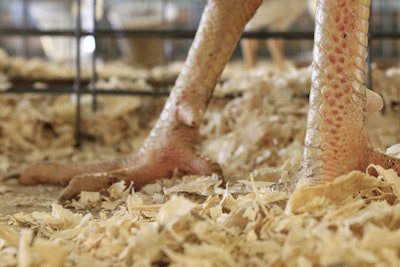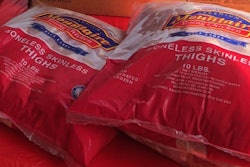
Investing in systems that ensure a drier litter in poultry houses might seem expensive, but it should more than pay off in the end.
Connie Mou, technical services manager for Jones-Hamilton, stressed the importance of dry litter during The Poultry Federation Poultry Symposium for Production & Processing on April 14.
While it may be commonly known in the poultry industry that damp litter can lead to poor paw health, Mou pointed out that some people may not know how important good chicken paws are for a poultry integrator’s bottom line.
According to Mou, paws account for about 3% of a bird’s weight. For a complex that has 2 million nine-pound birds, that amounts to about 540,000 pounds of paws. At an average price of $1.25 per pound, paws can bring in as much as $675,000 in weekly revenue, or $35.1 million in annual revenue.
Sources of litter moisture
Mou said there are essentially three sources of moisture in poultry houses: Heaters, drinkers and the birds themselves.
Heaters are only a small contributor, but possibly more than many people realize. By converting that gas into heat in our house, we are actually producing water. Burning one gallon of propane could produce 0.81 gallons of water.
“Not a lot, but we are still bringing moisture into the house,” Mou said.
Drinkers contribute as well. However, most of this is caused by either leaky drinkers, which can be easily fixed, or pressure settings that are too high and result in spillage. Drinker height also plays a role.
However, the birds themselves are the biggest contributor to litter moisture, Mou said.
“Roughly 80% or more of the water being consumed by our birds is actually being deposited right back into the house,” said Mou. “So it’s pretty much safe to assume that the moisture we need to remove from our houses is the amount that the birds are drinking each day.”
Means of moisture control
Mou said it is important to track how much water is entering the house for the birds to drink, so having an accurate water meter is essential.
Producers should also have a reliable sensor to measure the relative humidity in the house. The ideal target humidity rate should be between 40% and 60%, she said, and managing humidity is a daily task.
However, the right fans to create appropriate air movement to dry the litter may be what’s most important.
“Research has shown that the more air movement you have, the more water that you can potentially dry from the litter,” she said. “Some other research has shown that higher air movement at floor level can achieve drier litter.”
Mou cited one example in which one barn with air movement at less than 50 feet per minute had about 10% more litter moisture than another barn with air movement of around 150 feet per minute.
Many poultry houses ventilate through lower-volume fans that circulate air near the ceilings. However, Mou said the industry should think a little differently. By replacing low-volume fans with high-volume fans that can move air in the house a little differently, producers can get drier litter, and litter with a moisture content that is more consistent throughout the house, she said.
Improve broiler litter quality with increased air circulation: www.WATTPoultry.com/articles/33918




.jpg?auto=format%2Ccompress&fit=crop&h=167&q=70&w=250)












